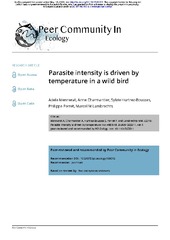| dc.contributor.author | Mennerat, Adele | |
| dc.contributor.author | Charmantier, Anne | |
| dc.contributor.author | Hurtrez-Boussès, Sylvie | |
| dc.contributor.author | Perret, Philippe | |
| dc.contributor.author | Lambrechts, Marcel M. | |
| dc.date.accessioned | 2020-07-03T09:47:06Z | |
| dc.date.available | 2020-07-03T09:47:06Z | |
| dc.date.issued | 2019 | |
| dc.Published | Mennerat A, Charmantier A, Hurtrez-Boussès S, Perret P, Lambrechts MM. Parasite intensity is driven by temperature in a wild bird. Peer Community in Ecology (PCI Ecology). 2019 | eng |
| dc.identifier.issn | 2606-4979 | en_US |
| dc.identifier.uri | https://hdl.handle.net/1956/23312 | |
| dc.description.abstract | Increasing awareness that parasitism is an essential component of nearly all aspects of ecosystem functioning, as well as a driver of biodiversity, has led to rising interest in the consequences of climate change in terms of parasitism and disease spread. Yet empirical knowledge on the extent and ways in which climatic factors affect parasite prevalence and intensities remains scarce. In an 18-year, multi-site, correlative study we investigated the contributions of weather variables and other factors to spatio-temporal variation in infestation by blowfly parasitic larvae (Protocalliphora spp.) in nests of Corsican blue tits (Cyanistes caeruleus). We found that ambient temperature during the nestling stage is strongly and positively related to parasite load (number of parasites per chick), both across broods when controlling for year, and across years. In addition, annual mean parasite load also increased with minimal spring temperature, and decreased with increasing average temperature in the previous summer. There was no indication of a dependence of parasite dynamics on host dynamics in this system, likely due in part to the wide host range of blowflies that do not solely rely on blue tit hosts. This suggests a major effect of temperature during the blowfly life cycle, with potential implications for blowfly – host interactions across their geographical range as climate keeps warming up. Finally, given that ambient temperature increases throughout the breeding season and that blowflies negatively affect survival and recruitment of blue tits, these results also mean that parasites, along with caterpillar availability, can drive selection for breeding date in this system. | en_US |
| dc.language.iso | eng | eng |
| dc.publisher | Peer Community | en_US |
| dc.rights | Attribution-Non Commercial-No Derivatives CC BY-NC-ND | eng |
| dc.rights.uri | http://creativecommons.org/licenses/by-nc-nd/4.0/ | eng |
| dc.title | Parasite intensity is driven by temperature in a wild bird | en_US |
| dc.type | Peer reviewed | |
| dc.type | Journal article | |
| dc.date.updated | 2020-01-23T10:36:40Z | |
| dc.description.version | publishedVersion | en_US |
| dc.rights.holder | Copyright 2019 The Authors | en_US |
| dc.identifier.doi | https://doi.org/10.1101/323311 | |
| dc.identifier.cristin | 1780718 | |
| dc.source.journal | Peer Community in Ecology (PCI Ecology) | |

